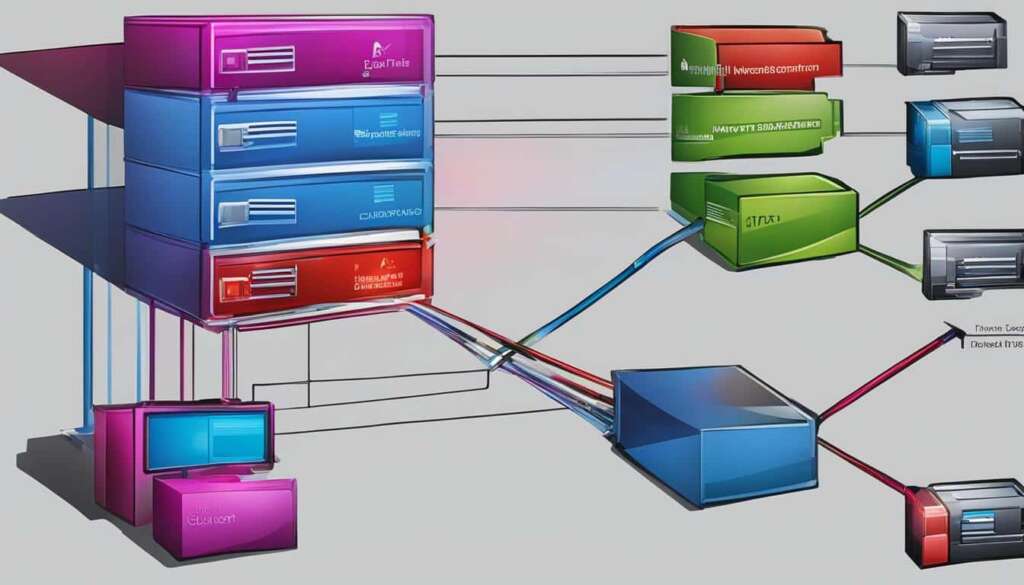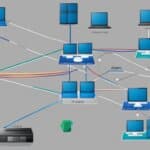Table of Contents
In today’s data-driven world, effective data traffic management is critical to ensure seamless operations and consistent performance. One of the fundamental components of managing data traffic is the use of network trunks.
A network trunk provides a high-capacity connection that allows multiple data streams to be transmitted simultaneously, ensuring efficient data transfer between switches, routers, or other network devices. Understanding the concept of network trunks is crucial for network administrators and IT professionals involved in designing and managing complex networks.
Key Takeaways
- Network trunks play a crucial role in managing data traffic in modern networks.
- They provide high-capacity connections for transmitting multiple data streams simultaneously.
- Trunks simplify data traffic management by enhancing network performance.
- They offer increased bandwidth, improved fault tolerance, and more efficient resource utilization.
- Understanding the concept of network trunks is crucial for designing and managing complex networks.
What is a Trunk in Networking?
When it comes to networking, a trunk refers to a high-capacity connection that lets you transmit multiple data streams simultaneously. Essentially, a trunk acts as a channel for carrying aggregated traffic between different network devices, such as switches and routers.
Trunks are an incredibly useful feature for organizations that need increased bandwidth and efficient data transfer capabilities. They can help reduce congestion and bottlenecks, ensuring that data flows smoothly between devices in complex networks.
“Creating trunks can help simplify network management and reduce the need for individual connections between devices.
Trunks are commonly used in enterprise-level data centers and other environments where there is a high demand for data transfer and management. By aggregating multiple connections into a single trunk, you can streamline network management and reduce overall maintenance costs.
Overall, trunks are an essential component of modern networking, and understanding how they work is crucial for IT professionals and network administrators.
Conclusion
Network trunks are an essential component of modern networking infrastructure. They provide a reliable and efficient means of managing data traffic by aggregating multiple data streams into a single high-capacity connection. By leveraging trunks effectively, network administrators can ensure seamless data flow, reduce bottlenecks, and improve network performance.
One of the key benefits of trunks is that they offer increased bandwidth, which allows for the transmission of large amounts of data at high speeds. This is especially important in data-driven environments, where fast data transfer is essential for meeting the needs of users and applications.
Trunks also improve fault tolerance by enabling redundant links between network devices. This means that if one connection fails, traffic can be automatically rerouted through another link, ensuring minimal disruption to network operations.
Finally, trunks enable more efficient resource utilization by reducing the number of physical connections required between network devices. This not only reduces costs but also makes it easier to manage and maintain the network over time.
Overall, understanding the concept of network trunks is crucial for IT professionals involved in designing and managing complex networks. By leveraging trunks effectively, organizations can ensure that their networks are scalable, reliable, and able to meet the demands of today’s data-intensive environments.
FAQ
What is a network trunk?
A network trunk is a high-capacity connection that allows the simultaneous transmission of multiple data streams. It serves as a channel for carrying aggregated traffic between switches, routers, or other network devices.
How does a network trunk benefit data traffic management?
By using network trunks, data traffic can be efficiently managed by allowing for increased bandwidth and more efficient data transfer. Trunks help prevent bottlenecks and enhance network performance.
Are network trunks important in modern networking?
Yes, network trunks play a vital role in modern networking. They simplify data traffic management, offer increased bandwidth, improve fault tolerance, and enhance resource utilization for network administrators and IT professionals.
What are the key advantages of using network trunks?
Some key advantages of network trunks include seamless data flow, minimized bottlenecks, and the ability to meet the growing demands of data-driven environments.
Who should be familiar with network trunks?
Network administrators and IT professionals involved in designing and managing complex networks should have a solid understanding of network trunks and their efficient utilization.













